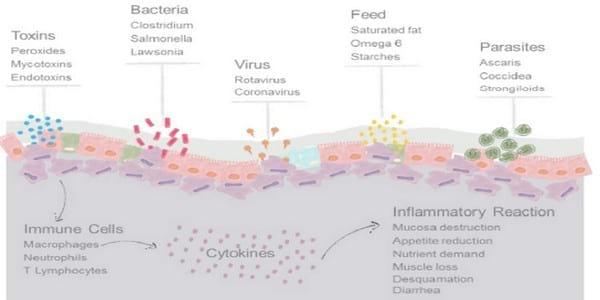Inflammation – causes, mechanisms and counteraction
Published: August 8, 2016
By: Phytobiotics; Julia Schmitt.
Cause and basic mechanisms
Inflammation is an important defense mechanism of the innate immune system. It is established within minutes after infection. It is meant to supply further effecting molecules and cells to support primary active macrophages and act as a physical barrier to separate local pathogen invaded tissue from healthy parts. Body barriers such as dermal skin, the intestinal mucosa, or respiratory tissue are confronted with direct contact to the environment and thus with various antigens throughout the day. Inflammation can be caused indirectly via stress or directly through tissue damage or through pathogens including viruses, bacteria, and parasites. But also other foreign substances such as feed ingredients can be pro-inflammatory factors. For the intestinal tract, Niewold (2012) mentions metabolic inflammation as a normal post-prandial action. The immune system has constantly to “decide”, if invading organisms are tolerated or fought against. This makes the environmental contact areas less sensitive than other parts of the body, but also puts some particular importance to them by serving as the first defense line. In general it becomes clear that (sub-) inflammatory process running constantly, the immune system is activated and requires a tight regulation. Unfortunately, this cannot always be realized and an overreaction of inflammatory mechanisms may occur.
At the site of infection, inflammation is initiated by the response of macrophages to pathogens or tissue damage (oxidized arachidonic acid). Cytokines are secreted by macrophages and contribute as messenger molecules in order to direct further cells to the infected area. The accumulation of neutrophils and release of enzymes and oxygen radicals (ROS) enhances the inflammatory reaction. Basic symptoms, which are usually dedicated to inflammation, are pain, heat, redness, swelling and loss of function. The described symptoms can be explained by widened blood vessels and thus increased blood flow, activated endothelial cells lining the blood vessel to express adhesion molecules that promote the binding of circulating leukocytes, increased vascular permeability and local accumulation of fluids and proteins in tissue (edema) (Janeway, Travers and Walport, 2001).

Consequences
Even though inflammation at the first glance is a positive intention of the body to defend itself, it initiates destructive mechanisms, which can also lead to permanent tissue damage. Necrosis on the intestinal wall can reduce the function of cells and also local integrity and absorption mechanisms. But, even before non-reversible effects occur, inflammatory processes cause performance loss, which can be explained by cytokine mediated activities such as muscle catabolism, hypothalamus regulated anorexia and fever, acute phase protein (APP) production in the liver, leucocyte production in bone marrow and accelerated turnover of the intestinal tissue. Several studies provide data of the energy and nutrient demand of immune mechanisms. As summarized by Lochmiller and Deerenberg (2000), sepsis or inflammation can require up to 30% of the bodies available energy. Also vaccination or an endotoxin challenge can cause similar increased energy demands. As stated by Klasing (1988), protein and trace minerals demand clearly is increased and altered in phases of inflammation. This is the reason for worsened feed conversion ratios and poor growth development in livestock animals.
Not only does intestinal inflammation cause changes in the hosts metabolism, but also may alter the intestinal environment. Due to the lowered nutrient absorption capacity of the intestine and rising blood flow in inflamed damaged tissue, the level of nutrients for bacteria increases and changes the microbiota to a dysbiotic condition, which may cause increased toxin production and favors the growth of specific pathogens, which benefit from inflammation such as Salmonella for example. This in turn can cause diarrhea and reduced intestinal integrity with widened tight junctions between cells and accelerates the downward spiral to decreased performance like a vicious circle.
Measurement
For diagnostic methods of inflammatory pathways blood analyses on specific inflammatory markers can give a clearer picture on ongoing processes in the animal. Besides general blood count, APPs such as haptoglobin, serum amyloid A, C reactive protein etc. play an important role for systemic inflammation. Depending on species and age, different parameters can be chosen for interpreting the health state of an animal. Several on-farm test kits for specific parameters are already available. For poultry and here notably in broilers, it was detected in the recent years, that broilers became less sensitive in acute phase reactions and thus not every parameter can be used anymore. This may be a side effect of breeding towards performance and reduced lipopolysaccharide-sensitivity.

Fighting strategies
There are several strategies in fighting inflammation. One common group are the non-steroidal anti-inflammatory drugs (NSAIDs). As many of those compounds inhibit important enzymes of the inflammatory cascade in a non specific way (Cox1 + Cox2 inhibition), they often do have negative side effects when used too often. One of the most well known products of this group is acetylsalicylic acid. But also some antibiotics formerly used as growth promoters had been adjudicated to have anti-inflammatory mechanisms by accumulating in inflammatory cells and inhibiting their inflammatory response (Niewold, 2007). Specific herbal compounds being used as feed additives are known for their anti-inflammatory effects, too, and are one of the 21th centuries “new” or “revitalized” approaches in fighting inflammation.

Related topics:
Authors:
Phytobiotics
Recommend
Comment
Share
Food & Allied Group of Companies
4 de noviembre de 2016
Herbal products in poultry is becoming popular especially as alternatives to antibiotics. The role of Sangrovit is well stated in this paper. Inflammation is very complex. In the field, we do not put great emphasis on this aspect in the broilers. But, we should understand the mechanism in the birds.
Recommend
Reply
Recommend
Reply

Would you like to discuss another topic? Create a new post to engage with experts in the community.










.jpg&w=3840&q=75)